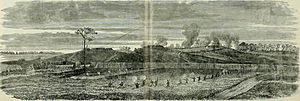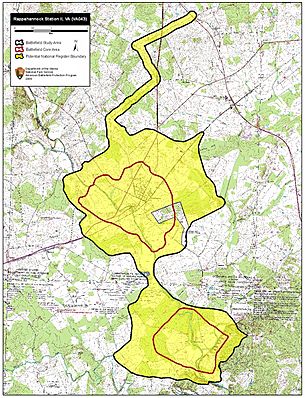Second Battle of Rappahannock Station facts for kids
Quick facts for kids Second Battle of Rappahannock Station |
|||||||
|---|---|---|---|---|---|---|---|
| Part of the American Civil War | |||||||
|
|||||||
| Belligerents | |||||||
| Commanders and leaders | |||||||
| George G. Meade | Robert E. Lee | ||||||
| Strength | |||||||
| 2,000 | 2,000 | ||||||
| Casualties and losses | |||||||
| 419 (Killed, wounded or captured) | 1,670 (Approx 1,600 captured) | ||||||
The Second Battle of Rappahannock Station happened on November 7, 1863. It took place near a village called Rappahannock Station, which is now Remington, Virginia. This area was along the Orange and Alexandria Railroad.
The battle was fought between Confederate forces led by Maj. Gen. Jubal Early and Union forces under Maj. Gen. John Sedgwick. It was part of a larger series of fights known as the Bristoe Campaign during the American Civil War. The Union army won this battle.
Contents
Why the Battle Happened
After the Battle of Gettysburg in July 1863, the Union and Confederate armies moved south. For about three months, they had small fights in the plains of northern Virginia. Not much changed during this time.
In late October, Confederate General Robert E. Lee moved his army behind the Rappahannock River. He hoped to stay there for the winter.
Lee's River Defense Plan
Lee had only one way to cross the river to the north side: a pontoon bridge (a temporary bridge made of boats) at Rappahannock Station. This bridge was protected by a strong defense on the north bank. This defense included two small forts, called redoubts, and connecting trenches. Confederate cannons on hills south of the river also helped protect the area.
Lee wanted to hold this bridge crossing. He thought it would let him threaten any moves the Union army might make. This would force the Union army to split its forces. Then, Lee hoped to attack one part of their army.
Union's Plan to Cross
The Union Army of the Potomac was led by Maj. Gen. George G. Meade. He decided to split his forces, just as Lee expected. Meade ordered Maj. Gen. John Sedgwick to attack the Confederate position at Rappahannock Station. At the same time, Maj. Gen. William H. French was to cross the river five miles downstream at Kelly's Ford. Once both Sedgwick and French were safely across, the Union army would join up again at Brandy Station.
The Battle Unfolds
The Union plan started well. Shortly after noon on November 7, French pushed back the Confederate defenders at Kelly's Ford and crossed the river. As this happened, Sedgwick moved towards Rappahannock Station.
Lee learned about these events after noon. He quickly moved his troops to meet the enemy. His plan was to hold off Sedgwick with a small force at Rappahannock Station. Meanwhile, the main part of his army would attack French at Kelly's Ford. This plan needed the Rappahannock Station bridge crossing to hold until French was defeated.
First Clashes
Sedgwick's forces first met the Confederates at 3 p.m. Maj. Gen. Albion P. Howe's division from the Sixth Corps pushed back Confederate skirmishers (soldiers who scout ahead and fight in small groups). They took control of high ground about three-quarters of a mile from the river. Howe placed Union cannons on these hills. These cannons fired "rapid and vigorous" shots at the enemy's earthworks (defensive walls made of earth). Confederate cannons across the river fired back, but they didn't do much damage.
Maj. Gen. Jubal Early's division was defending the bridge crossing that day. Early placed Brig. Gen. Harry T. Hays's Louisiana brigade and Captain Charles A. Green's four cannons in the defenses. At 4:30 p.m., he sent three more North Carolina regiments, led by Colonel Archibald Godwin, to help. This brought the number of Confederate defenders at the bridge crossing to nearly 2,000.
The Surprise Attack
Sedgwick kept firing cannons at the Confederates through the late afternoon. But he didn't seem ready to attack with his soldiers. As the day ended, Lee thought the attack on the bridge crossing was just a trick. He believed it was meant to hide French's crossing further downstream. But Lee was wrong.
At dusk, the cannon fire stopped. Suddenly, Sedgwick's infantry (foot soldiers) rushed forward. Colonel Peter Ellmaker's brigade moved next to the railroad. The skirmishers of the 6th Maine Infantry led the way. They were told "Forward, double-quick!" and quickly moved over the Confederate defenses. They fought Hays's men hand-to-hand. The 6th Maine broke through the Confederate line and put their flags on the wall of the eastern fort. Moments later, the 5th Wisconsin climbed over the walls of the western fort, taking it from Confederate control.
On the right side of the Union attack, things went just as well. Minutes after Ellmaker's brigade broke through Hays's line, Colonel Emory Upton's brigade took over Godwin's position. Upton quickly reorganized his lines inside the Confederate defenses. He sent part of the 121st New York to capture the pontoon bridge. The rest of his soldiers turned right to attack the confused Confederate soldiers gathered at the end of the bridge crossing.
Confederate resistance quickly fell apart. Hundreds of soldiers dropped their weapons and gave up. Others tried to swim across the icy river or run across the bridge while Union soldiers shot at them. Confederate troops south of the Rappahannock River could only watch as Union soldiers rounded up their comrades as prisoners of war.
What Happened Next
In total, 1,670 Confederates were killed, wounded, or captured in this short battle. This was more than eighty percent of their forces involved. Union losses, however, were much smaller: 419 in total.
For the North, the battle was a "complete and glorious victory." It was a fight that was "as short as it was decisive." Maj. Gen. Horatio G. Wright pointed out that it was the first time Union troops had captured a strong Confederate position in their first attack. Brig. Gen. Harry Hays, on the Confederate side, claimed he was attacked by 20,000 to 25,000 Union soldiers. This number was actually ten times higher than the real number.
The battle was very embarrassing for the South. Two of the Confederacy's best brigades, protected by strong defenses and supported by cannons, were defeated and captured by a Union force of similar size. Colonel Walter H. Taylor from Lee's staff called it "the saddest chapter in the history of this army." An enlisted soldier simply said, "I don't know much about it, but it seems to be that our army was surprised."
Lee later asked his officers to write reports about the battle to find out what went wrong. But on the night of November 7, he had more urgent problems. Losing the bridge crossing ruined his plans for an attack. It also left his army spread out and unable to defend their position well. Meade, the Union commander, could act quickly and trap Lee's army against the Rapidan River. This was similar to how Lee had tried to trap Maj. Gen. John Pope's army a year earlier at the Second Battle of Bull Run. Lee immediately canceled his plans to attack French. Within hours, his army was marching south.
Preserving the Battlefield
As of November 2021, the American Battlefield Trust and its partners have helped save 869 acres (about 3.5 square kilometers) of the battlefield. This is where both the First and Second Battles of Rappahannock Station were fought. The battleground is located along the Rappahannock River near Remington, Virginia. You can still see some of the old earthworks (defensive walls) and ruins of bridges and mills. However, many of the earthworks at Remington are gone, and more than 75% of the battlefield has been developed with buildings.



